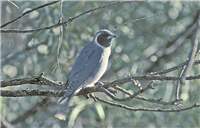Family
Artamidae
Genus
Armatus
Species
personatus
Threats/Control Methods - Regional
The woodland habitat of the Masked Woodswallow has been recognised as an Endangered Ecological Community, as it only covers a tiny percent of its original area due to land clearing for agriculture and urban development, grazing and weed infestations.
Threats/Control Methods - Local
Droughts are a local threat that brings the birds into the suburbs for more reliable water, thus putting them at an increased risk of attack from domestic pets.
Local/Urban Actions
The preservation of large areas of suitable woodland habitat is key to the survival of this species. This is facilitated through local Landcare groups or Greening Australia. Cat owners can prevent their pets preying on the species by providing a stimulating indoor environment and by installing a cat run or enclosure.
Common Names
Masked Woodswallow, Blue Martin, Bush Martin, Skimmer
Distinguishing Features
The soft, powdery plumage of this medium-sized, 19-20cm bird, consists of different shades of grey. Males have a black mask over their eye and cheek, bordered with a white line around the neck. Females have a dusky face and more pink-grey breast. Young birds are similar to the female, although slightly browner with some light flecks.
Survey Techniques
Call and visual identification.
Species Call
A nasal 'churrt' and 'chuk' or a soft 'chrrup'. Some mimicry.
Similar Species
This bird is regularly seen in flocks with the White-browed Woodswallow (Artamus superciliosus), diferenciated by the chestnut-coloured underparts of the white-browed species. The same grey plumage and black face is seen in the Black-faced Cuckoo-shrike (Coracina novaehollandiae ), but the cuckoo is much larger at 30-36cm.
Distribution
This species is found across Australia, excluding the most northern areas and TAS. Locally, flocks may be seen across the southern Tablelands and Monaro regions from time to time.
Country of Origin
Australia
Conservation (Pet/Pest) Status - Regional
This is a rare visitor to the ACT (Veerman).
Conservation (Pet/Pest) Status - National
Secure, not listed under the EPBC Act 1999.
LSCCES Population
Three sightings were made in Turner.
Associated vegetation community
Masked Woodswallows inhabit open forest, woodland, heath and small vegetation patches along roads or near farms.
Limiting Resources
This species depends on water, as it is most likely to breed after major rain events.
Breeding
The breeding season generally runs throughout August to December, or after major rain events. A breeding pair builds an untidy nest of twigs about 1-3 metres from the ground. Nests can be found in dense bushes or in clumps on the side of tree trunks. They will also use tree stumps or the discarded nests of Australian Magpies (Gymnorhina tibicen ). A clutch size is 3-4 eggs, which are densely covered in brown speckles. Both parents share incubation and feeding.
Behaviour
This species can be seen flying high in large noisy flocks, soaring for hours. They often join with the more regionally common flocks of White-browed Woodswallows (Artamus superciliosus) and are short-term visitors to the Canberra region. They generally migrate north for winter, following insect abundance.
Functional Group
Food Species
Masked woodswallows grab insects swiftly in-flight while fluttering and gliding.
Predators
Feral or domestic Cats (Felis catus) or European Red Foxes (Vulpes vulpes) may attack young Masked Woodswallows, especially when nests are in accessible locations.
Interesting Fact
Woodswallows keep their flocks of hundreds of birds together by chirping to one another constantly.
References - (reader suitability of references, P=Primary teachers, S=Secondary students, T=Tertiary students and researchers)
Books:Morcombe, M. 2000. Field Guide to Australian Birds. Steve Parish Publishing. Archerfield. Australia P, S, T
Schodde, R. and Tideman, S. (eds) 1990. Reader's Digest Complete Book of Australian Birds (2nd Edition). Reader's Digest Services Pty Ltd. Sydney. P, S, T
Taylor, M. and Day, N. 1993. Field Guide to the Birds of the ACT. National Parks Association of the ACT Inc. Canberra. P, S, T
Veerman, P. 2003. Canberra Birds: A report on the first 21 years of the garden bird survey. Philip Veerman and Canberra Ornithologists Group. Canberra. S, T
Online Publications:ACT Government. 2004. Woodlands for Wildlife: ACT Lowland Woodland Conservation Strategy. Action Plan No. 27. Environment ACT, Canberra. [online]. Available at: http://www.environment.act.gov.au/nativeplantsandanimals/threatecspec/woodlandsstrategy S, T
Nix, H. and Cunningham, R. 2006. Birds of the Lower Sullivans Creek Catchment, Canberra ACT. Prepared for the Life in the Suburbs project using data from the Lower Sullivans Creek Catchment Ecological Survey (LSCCES). Australian National University. Canberra. [online]. Available at: http://www.lifeinthesuburbs.com.au/category.php?id=65 S, T

 Top
Top Top
Top